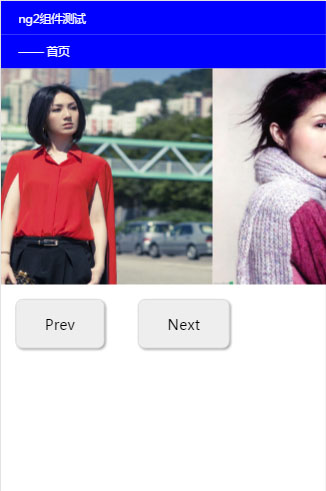您好,登錄后才能下訂單哦!
您好,登錄后才能下訂單哦!
這篇文章主要介紹了Angular2如何使用組件與指令實現圖片輪播組件,具有一定借鑒價值,感興趣的朋友可以參考下,希望大家閱讀完這篇文章之后大有收獲,下面讓小編帶著大家一起了解一下。
一、創建組件
結束上文打的尷尬的比方,著眼于一個待開發的ng2項目,它有一個空白的特性頁面,現在需要在上面呈現一個圖片輪播窗口。
圖片輪播是一個需要給用戶看見的東西,所以應該使用ng2的組件(Component)來實現它,并且這個功能較為通用,可以將其獨立出來方便以后再次使用到。
所以在項目中的共享模塊(SharedModule)下創建這個組件名為 slide-img.component。
使用ng2提供的組建裝飾器來將這個TypeScript模塊正式變身成ng2的組件:
@Component({
selector: 'my-slide-img',
templateUrl: 'slide-img.component.html',
styleUrls: ['slide-img.component.css'],
animations: [
trigger('imgMove', [
/** 不顯示 */
state('off', style({'display': 'none', 'z-index': '0', 'transform': 'translateX(0)'})),
/** 上一張圖片 */
state('prev', style({'z-index': '1',
'transform': 'translateX(-100%)'})),
/** 下一張圖片 */
state('next', style({'z-index': '2', 'transform': 'translateX(100%)'})),
/** 當前圖片 */
state('on', style({'z-index': '3', 'transform': 'translateX(0)'})),
transition('prev=>on', [
animate('0.3s ease-in')
]),
transition('next=>on', [
animate('0.3s ease-in')
]),
transition('on=>prev', [
animate('0.3s ease-in')
]),
transition('on=>next', [
animate('0.3s ease-in')
])
])
]
})
export class SlideImgComponent { }其參數其實已經不能再明確了:
selector就是其使用時的標簽名,
templateUrl即組件關聯的界面的模板,
styleUrls即僅在此組件內生效的樣式表,
animations定義的是一套ng2動畫規則。
講講最后的這個動畫規則:
ng2的動畫其實非常簡單,步驟為1.定義觸發器名,2.定義狀態,3.定義切換樣式,4.將此觸發器應用到具體的標簽中,狀態作為觸發器的值傳入。
當ng2檢測到動畫狀態的值更改了,就會套用定義的切換樣式,用法思路還算比較明確(當然實際使用時會有一些尷尬的小問題)
二、實現組件
既然是輪播圖片組件,要做的事情首先就得是傳入輪播圖片然后顯示出來。
使用過ng1的朋友一定還記得其在定義指令(angular.directive)的時候是通過scope參數(或者link)來傳入數據的,而ng2中使用的是Input裝飾器,使用的方法如下:
@Input() public imgs: SlideImg[];
使用了此裝飾器的變量imgs將可以在運行時接收其他組件傳入的圖片列表。使用方法如下:
<my-slide-img [imgs]="imgs"></my-slide-img>
關于這里的方括號“[]”,ng2其實提供了多種方式來進行組件模板中值的傳入,其中這種變量名用方括號包起來的方法就是其中之一,代表是輸入的值,而后面會見到的圓括號來包圍的方式,是代表輸出的值。
傳入了數據后,下一步就是要如何來顯示圖片到界面上了,沒錯就是ng1中ng-for指令的升級版*ngFor,除了寫法外表面上的差別不大。
關于輪播圖片邏輯的具體實現邏輯,筆者使用的方式就是利用ng2動畫的狀態切換,設置一個當前圖片索引值current,*ngFor渲染的圖片將其索引與當前索引比較,如果是相鄰的圖片則設為'prev'狀態與'next'狀態,ng2會為其加上位置屬性為-100%或者100%,如果是當前圖片則設為'on'狀態,ng2會將其的位置屬性設為0,其余均設為'off'狀態,ng2會直接將其隱藏,實現的邏輯很簡單,考慮也不算周全,筆者就不繼續解釋獻丑了。
最終的輪播圖片組件及其模板文件代碼如下:
<div class="imgs">
<img src="{{img.Url}}" alt="" class="img"
*ngFor="let img of imgs;let i=index"
(mySwipe)="Change($event)"
[@imgMove]="ImgState(i)">
</div>
<div class="btn" (click)="Prev()">Prev</div>
<div class="btn" (click)="Next()">Next</div>.imgs{
position: relative;width: 100%;height: 15em;
overflow: hidden;
}
.img{
position: absolute;
width: 100%;
height: 100%;
background: pink;
transition: 0.2s;
}
.btn{
display: inline-block;
padding: 1em 2em;font-size: 1em;border-radius: 0.5em;
border: 1px solid #ddd;cursor: pointer;
margin: 1em;background: #eee;box-shadow: 0.1em 0.1em 0.2em #aaa;
}
.btn:active{
background: #eee;
box-shadow: none;
}import { Component, OnInit, Input,
animate,
style,
transition,
trigger,
state,
HostListener
} from '@angular/core';
import { SlideImg } from './slide-img.interface';
@Component({
selector: 'my-slide-img',
templateUrl: 'slide-img.component.html',
styleUrls: ['slide-img.component.css'],
animations: [
trigger('imgMove', [
/** 不顯示 */
state('off', style({'display': 'none', 'z-index': '0', 'transform': 'translateX(0)'})),
/** 上一張圖片 */
state('prev', style({'z-index': '1',
'transform': 'translateX(-100%)'})),
/** 下一張圖片 */
state('next', style({'z-index': '2', 'transform': 'translateX(100%)'})),
/** 當前圖片 */
state('on', style({'z-index': '3', 'transform': 'translateX(0)'})),
transition('prev=>on', [
animate('0.3s ease-in')
]),
transition('next=>on', [
animate('0.3s ease-in')
]),
transition('on=>prev', [
animate('0.3s ease-in')
]),
transition('on=>next', [
animate('0.3s ease-in')
])
])
]
})
export class SlideImgComponent {
@Input() public imgs: SlideImg[];
public current;
constructor() {
this.current = 0;
}
public ImgState(index) {
if (this.imgs && this.imgs.length) {
if (this.current === 0) {
return index === 0 ? 'on' :
index === 1 ? 'next' :
index === this.imgs.length - 1 ? 'prev' :
'off';
} else if (this.current === this.imgs.length - 1) {
return index === this.imgs.length - 1 ? 'on' :
index === this.imgs.length - 2 ? 'prev' :
index === 0 ? 'next' :
'off';
}
switch (index - this.current) {
case 0:
return 'on';
case 1:
return 'next';
case -1:
return 'prev';
default:
return 'off';
}
} else {
return 'off';
}
}
public Next() {
this.current = (this.current + 1) % this.imgs.length;
}
public Prev() {
this.current = this.current - 1 < 0 ? this.imgs.length - 1 : this.current - 1;
}
public Change(e) {
if (e === 'left') {
this.Next();
} else if (e === 'right') {
this.Prev();
}
}
}其中有兩個地方為講到,一個是組件代碼引入了一個slide-img.interface 模塊,這個僅僅用來規范一下輪播圖片的格式,二是在html中還有一個節點名為(mySwipe)這就是接下來要講的輸出屬性,目前知道的它的作用是,當用戶滑動圖片時,將觸發此節點配置的回調方法,所做的事情就是判斷發生了左滑事件還是右滑事件,分別觸發上一張圖或下一張圖的切換。
三、給輪播圖片控件加上手勢效果
輪播圖片在移動端很需要加上手勢滑動的效果,所以接下來要給這個輪播組件加上一個指令,用于響應用戶的滑動手勢。代碼如下:
import { Directive, Input, HostListener, Output, EventEmitter } from '@angular/core';
@Directive({ selector: '[mySwipe]' })
export class SwipeDirective {
@Output() public mySwipe = new EventEmitter<string>();
private touchStartX;
private touchStartY;
@HostListener('touchstart', ['$event']) public onTouchStart(e) {
this.touchStartX = e.changedTouches[0].clientX;
this.touchStartY = e.changedTouches[0].clientY;
}
@HostListener('touchend', ['$event']) public onTouchEnd(e) {
let moveX = e.changedTouches[0].clientX - this.touchStartX;
let moveY = e.changedTouches[0].clientY - this.touchStartY;
if (Math.abs(moveY) < Math.abs(moveX)) {
/**
* Y軸移動小于X軸 判定為橫向滑動
*/
if (moveX > 50) {
this.mySwipe.emit('right');
} else if (moveX < -50) {
this.mySwipe.emit('left');
}
} else if (Math.abs(moveY) > Math.abs(moveX)) {
/**
* Y軸移動大于X軸 判定為縱向滑動
*/
if (moveY > 50) {
this.mySwipe.emit('down');
} else if (moveY < -50) {
this.mySwipe.emit('up');
}
}
this.touchStartX = this.touchStartY = -1;
}
}指令的聲明甚至簡單過組建的聲明,因為指令不需要依賴于某個視圖模板,只需要有個指令名稱就足夠了。
需要關心的是指令中定義的輸出屬性:
@Output() public mySwipe = new EventEmitter<string>();
此屬性接收了上文組件中的Change($event)回調方法,在此指令中,所做的事情就是監聽組件的滑動,收到滑動事件后就觸發這個回調,監聽使用的是ng2的HostListener裝飾器,用法顯而易見了。
現在運行起項目來看看效果吧(比較懶就不截動圖了):

總結以及題外話:
本文主要使用了ng2幾個比較基本的功能——輸入屬性(Input裝飾器)、輸出屬性(Outut裝飾器)、HostListener裝飾器、幾個系統指令(ngFor)、ng2動畫實現了一個比較基本的圖片輪播控件。
使用好ng2的組件以及指令能完成很多的事情,其需要學習的東西絕不僅限與本文提到的,包括其底層的渲染,也很值得去研究。
最后提一個尷尬的問題點:
其實最初寫這個輪播圖片的時候想過要加上拖動的,也就是圖片會隨手勢的滑動實時更新位置。
但后來發現ng2的動畫有個尷尬的地方,那就是一定會從初始狀態按照定義好的轉換效果變化到目標狀態。實時滑動需要我在滑動過程中就改變圖片的位置,這樣的話在滑動結束需要切換圖片時,圖片居然強行回到了初始位置然后才開始轉換動畫,一時還想不到繼續使用ng2動畫來實現這種實時滑動的完美解決辦法,實在是尷尬。
感謝你能夠認真閱讀完這篇文章,希望小編分享的“Angular2如何使用組件與指令實現圖片輪播組件”這篇文章對大家有幫助,同時也希望大家多多支持億速云,關注億速云行業資訊頻道,更多相關知識等著你來學習!
免責聲明:本站發布的內容(圖片、視頻和文字)以原創、轉載和分享為主,文章觀點不代表本網站立場,如果涉及侵權請聯系站長郵箱:is@yisu.com進行舉報,并提供相關證據,一經查實,將立刻刪除涉嫌侵權內容。